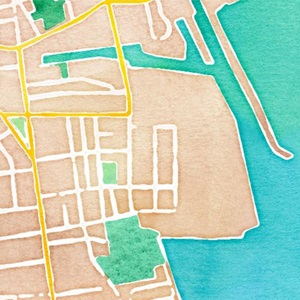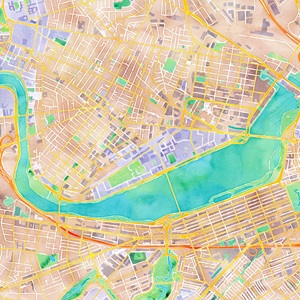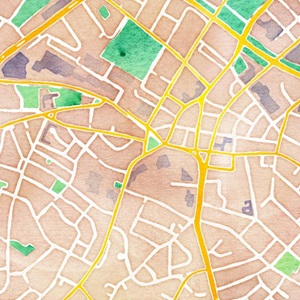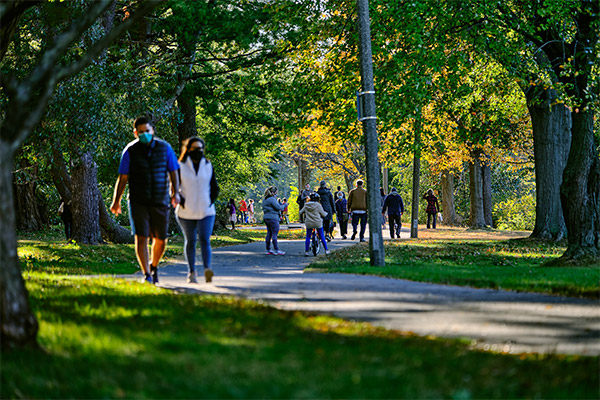
The places
The Place Leadership Network cohort reflects the diversity of Boston neighborhoods. Of the eight participating neighborhood teams, five serve communities of color: predominantly Afro-Caribbean Bowdoin-Geneva, Roxbury’s Nubian Square, historic Chinatown, Boston’s Latin Quarter, and a community of South American residents in Salem’s El Punto neighborhood. Two participants maintain open space networks that stitch together communities of varied socioeconomic profiles, with a focus on inclusive audience development. The last undertakes cultural placekeeping in a district that encompasses Cambridge’s largest public housing development, artist workspaces, and a sizable population of unhoused people.
“We’ll do it one artist, one contractor, one business owner at a time.”
-Tania Anderson, Executive Director, Bowdoin Geneva Main Streets, on creating an Afrocentric cultural and commercial district.
Chinatown, Boston
The Asian Community Development Corporation with the Chinese Historical Society of New England and Chinatown residents
Developer of housing and champion for residents and small businesses, the Asian Community Development Corporation began its time with the Leadership Network with the aspiration to expand and strengthen the identity of Chinatown. The team’s focus moving forward is to unlock the greatest potential of public spaces, generate goodwill, and connect long-time and new residents to become neighbors.
“Our emphasis on equity translated to urgency and wanting to pilot quick, low-scale projects. Centering healing shifted our approach in drastic ways: what is most important is not experimentation but trust.”
Chinatowns across America are shrinking due to intense pressure from gentrification and rising housing costs. Not only are residents and small business owners being displaced, but cities are losing their historic and cultural identity. How can we stop Boston’s Chinatown from becoming a forgotten relic?
Initial Goal: To extend Chinatown’s cultural footprint, flipping the narrative of a disappearing Chinatown into an expanding one. Our strategy was to use art and play to transform Phillips Square, an unused street along Chinatown’s northern edge, into a new gateway that reflected the origins and culture shaped by working-class, immigrant families.
Community Gardens, Boston
The Trustees of Reservations
Managing 56 community spaces across Boston, the Trustees of Reservations joined the Place Leadership Network seeking to develop a community-driven governance model that centers the interests of current neighborhood residents. The Trustees are now exploring network approaches to operating its community gardens, with specific attention to communicating across cultures and languages to increase access.
“The success will lie in the activation of neighborhood leadership. This is where our work needs to start from.”
The Trustees is the largest owner of community gardens in Boston. The Leyland Community Garden in the heart of the Dorchester’s Dudley Street neighborhood serves a broad body of residents, including a significant immigrant population. Approximately 20% of residents are Cape Verdean; 53% are African American and 23% are Latinx. We are working to cultivate grassroots leadership amidst a diverse and rapidly gentrifying neighborhood.
Initial Goal: For those who want to garden or get involved in a more direct way, we want to make that process more transparent and to break down any barriers—real or perceived—to doing so. To that end, we also need to better understand our neighborhoods and their needs.
Central Square, Cambridge
Central Square Business Improvement District, the Dance Complex, and the Community Art Center
Leading cultural placekeeping efforts in Cambridge’s Central Square, the Central Square BID team brought to the Place Leadership Network the ambition to create a sustainable community network and build collective capacity in the district. The team is now envisioning a unified “take back” of the neighborhood that builds on activating public spaces.
“We intend to build a strong and diverse coalition, network of leaders, and thoughtfully programmed neighborhood spaces that unite a divided community.”
Central Square serves as the traditional downtown for the City of Cambridge, playing many roles as a dense, vibrant, mixed-use district. Central Square is the beating heart of Cambridge that boasts as main assets its diversity and authenticity through its independent merchants, faith-based community, and local non-profits, including social services support and creativity cultivation through arts and cultural entities. Gentrification is not only driving out long-standing residents but also changing business ownership in the district. The rapid new changes are driving economic inequality, creating a tale of two cities.
Initial Goal: We intend to build a strong and diverse coalition, network of leaders, and thoughtfully programmed neighborhood spaces that unite a divided community. We will look to collaborate more deeply in arts partnerships, go beyond the doors of our studio to engage/reach; to use the lessons of the cohort to help us lay a foundation for the Central Square Cultural District.
The Charles River and the Esplanade, Boston and Cambridge
The Charles River Conservancy and the Esplanade Association
Responsible for maintaining and activating a ten-mile urban watershed of the Charles River, the Charles River Conservancy team entered the Place Leadership Network seeking closer collaboration within its team and with government agencies. During its time in the program, the team redoubled its focus on making programming along the Charles more inclusive, whether virtual or in person.
“From our experience with the PLN, we now see the opportunity to elevate the challenges and successes we face as park managers.”
The Charles River basin is the ultimate comeback story. A few short decades ago, the river was described as "foul and noisome, polluted by offal and industrious wastes, scummy with oil, unlikely to be mistaken for water" by Bernard DeVoto in Harper's Magazine. Today, after years of advocacy, planning, and both public and private investment to clean up the effects of industrial pollution, the Charles is one of the cleanest urban rivers in the United States. The Place Leadership Network team focuses on the “urban” Charles, 10 miles of land on both sides of the river, spanning across Boston, Cambridge, Allston/Brighton, and Watertown, including the Charles River Esplanade, the 64-acre riverfront park that stretches 3.3 miles from the Museum of Science to the Boston University Bridge on the Boston side of the river. Challenges include underfunded public partners, climate change, real and perceived lack of diversity, and a history of fragmentation.
Initial Goal: The Charles River Conservancy and Esplanade Association seek to take a disjointed and under-resourced system of management for the Charles River Basin parks and strengthen the nonprofit sector’s collaboration, collective voice, inclusivity, effectiveness, resources, and role.
Boston's Latin Quarter, Jamaica Plain
Hyde Square Task Force
Having recently received a designation as Boston’s Latin Quarter, Hyde Square Task Force entered the Place Leadership Network to frame its core youth development mission within a new body of place-based work. The organization is moving ahead with a holistic approach to its work, deepening relationships inside the district to uplift resident voice and inclusion.
“Our aim in this work is to maintain the neighborhood’s Latinx identity and history and also welcome and integrate newcomers into the Latin Quarter’s social fabric.”
With a 60-year history as the home for countless Latinx immigrants, Boston’s Latin Quarter has a rich heritage of Afro-Latin arts and culture. Hyde Square Task Force worked for several years on the concept of Boston’s Latin Quarter, which ultimately led to a cultural district designation in 2018. Although the Latin Quarter serves as a hub for Latinx culture, its residential demographic profile has changed significantly in recent years. The overall improvement in our neighborhood has attracted the attention of Boston residents and investors. Unfortunately, these changes have led to gentrification that has adversely impacted some of the neighborhood’s long-time residents. The increase in the cost of living has forced many low-income, Latinx families to move to other neighborhoods, such as Dorchester, Roxbury, and Hyde Park. This displacement threatens to erase the neighborhood’s historical identity as a safe haven for Latinx immigrants and culture. It also increases the urgency with which we must work to support the 65% of our businesses that are immigrant-owned, in order to decrease wealth disparity and increase economic stability.
Initial Goal: Our aim is to utilize Afro-Latin arts to serve as a means of building bridges and bonds between neighbors while welcoming visitors and tourists and creating a cultural home for the region’s Latinx population.
The Point, Salem
North Shore Community Development Coalition
Developer of accessible housing in Salem’s predominantly LatinX Punto neighborhood, the North Shore Development Coalition sought to amplify its core mission through arts-based initiatives. The Coalition is now revisiting messaging, including the branding and storytelling that accompanies the Punto Urban Art Museum, its signature public art initiative.
“Public spaces successfully engage residents and prevent isolation. They bring people together to celebrate similarities and differences.”
The Point neighborhood (or “El Punto”) is a dense, urban neighborhood adjacent to downtown Salem, Massachusetts. The neighborhood has been home to immigrant communities for over a century. In 2017, the Punto Urban Art Museum (PUAM) was founded with public art murals on North Shore CDC’s deed-restricted properties. We now host two annual events, a dedicated public space strictly for local artists, and seasonal educational tours. By the end of summer 2019, we will have more than 80 murals in the neighborhood and a solid base of school tours running Spring through Fall annually. PUAM is a mission-driven social justice art program led by North Shore CDC, a community development non-profit founded in the neighborhood in 1978. PUAM has two primary goals: 1) To create a beautiful, uplifting environment for Point residents, particularly for children, to grow up in and 2) To break down the invisible divide between the Point and the rest of Salem by inviting visitors into the Point to experience world-class art first-hand.
Initial Goal: North Shore CDC seeks to sustain PUAM and that requires dedicated staffing and resources. The main challenges for PUAM are to define the organizational structure and financial sustainability for this growing arts destination. Through stunning, world-class art, we want children in the Point neighborhood to grow up with pride, and we want the rest of the community to have a reason to visit and discover the welcoming community that we know and love. The urgent and tangible work for North Shore CDC is to focus on deepening the programs surrounding PUAM, specifically the visitor experience and educational programming.
Bowdoin Street and Geneva Avenue, Dorchester
Bowdoin Geneva Main Streets, Meetinghouse Hill Civic Association, and the Farmers Collaborative
The Bowdoin Geneva Main Streets team came to the Place Leadership Network well-versed in addressing racial and economic injustices in a historically disinvested, majority Afro-Carribean district. With the initial goal of partnering with city agencies to activate vacant parcels, the team used the program to formulate a broader narrative of change and collaboration across the district.
“We are curating a dominant narrative that connects community members' experiences to our initiatives in order to plant the seeds for more transformative policies.”
Bowdoin Street and Geneva Avenue intersect in the heart of Dorchester, forming a commercial district in between the Ashmont Red Line T stop and the Four Corners Indigo Line commuter rail stop. The Main Streets District is a regional destination for many and is home to a vibrant Cape Verdean community. While the majority of businesses are focused on personal hair care, restaurants and bars are in the mix as well. Like most predominantly Black communities, Dorchester’s Bowdoin Geneva is at the mercy of market forces threatening to displace longtime residents who have been relegated to this ethnic enclave because of the City’s racist history. The area also faces challenges due to its zoning code: most of the commercial district is zoned as “local convenience,” limiting business size and more. Other areas along the main streets are zoned residential, making a contiguous commercial district impossible. Given these restrictions, the area lacks banks, gyms, entertainment venues, and other businesses that could anchor the neighborhood.
Initial Goal: We hope that from this experience, we can successfully work with the Department of Neighborhood Development (DND) at the City of Boston to activate 20 vacant community lots to grow local and sustainable produce or create maker spaces for the community through land trusts. In addition, Dorchester has only four arts & entertainment licenses across our five business districts. We perceive the lack of culturally competent safe spaces for young Black people to commune as a public health issue as Black nightlife in Boston is an underground economy. We aim to provide a high-class, Afro-centric district that will allow the community to draw tourism dollars, capture the retail sales leakages, and grow the market base.
Nubian Square, Roxbury
Roxbury Cultural District
Tying together a cluster of cultural assets in Nubian and Elliott Squares, the Roxbury Cultural District joined the Place Leadership Network to explore potential community and economic development approaches, with a focus on impact and community benefits. Based on its participation, the District has secured additional funding to conduct a feasibility study around a real estate value capture mechanism.
“We want to move the district forward using the lens of abundance and as a collective force for upliftment and mutual community benefit.”
Roxbury is the geographic center of Boston and has seen both strategic disinvestment and intentional investment. It is a community with deep historic roots and a legacy of arts and cultural leadership. Uniquely positioned to become a required stop when visiting the city, Roxbury Cultural District (RCD) is home to a number of historic sites, outstanding architecture, and notable firsts in the country. As a transportation hub, Nubian Square welcomes approximately 50,000 commuters during a typical workday. Once its own city and later a booming business district, RCD has seen many shifts. Gentrification and the shifts caused by increasing community and economic development have created a community feeling of uncontrollable change. The district’s challenge is to acknowledge the rich history and contributions of existing residents while welcoming new opportunities.
Initial Goal: We were laser-focused on capturing opportunities during this current phase of change. The district has seen an accelerated rate of growth over the last five years. Our team was interested in exploring alternative partnerships with developers in the area. Excited by the potential benefits of collaborative partnerships, we were focused on advocating for the use of community benefits agreements as a tool to increase the number of arts & cultural spaces. We were confident that community benefits agreements that were framed as true partnerships would increase the likelihood of intentional programming that highlighted both community voice and community needs.











